NEAddiX in "Farbe und Lack" - NEA POWDER COATING NEWS
Dosing and Dispersing
REAL LIFE TESTING OF A DOSING AND DISPERSING SYSTEM SHOWS REDUCTION OF ADDITIVE CONSUMPTION BY UP TO 60 %.
by Marc Giersemehl, Christian Begass and Fabian Mertens published in "Farbe und Lack 2/2020"
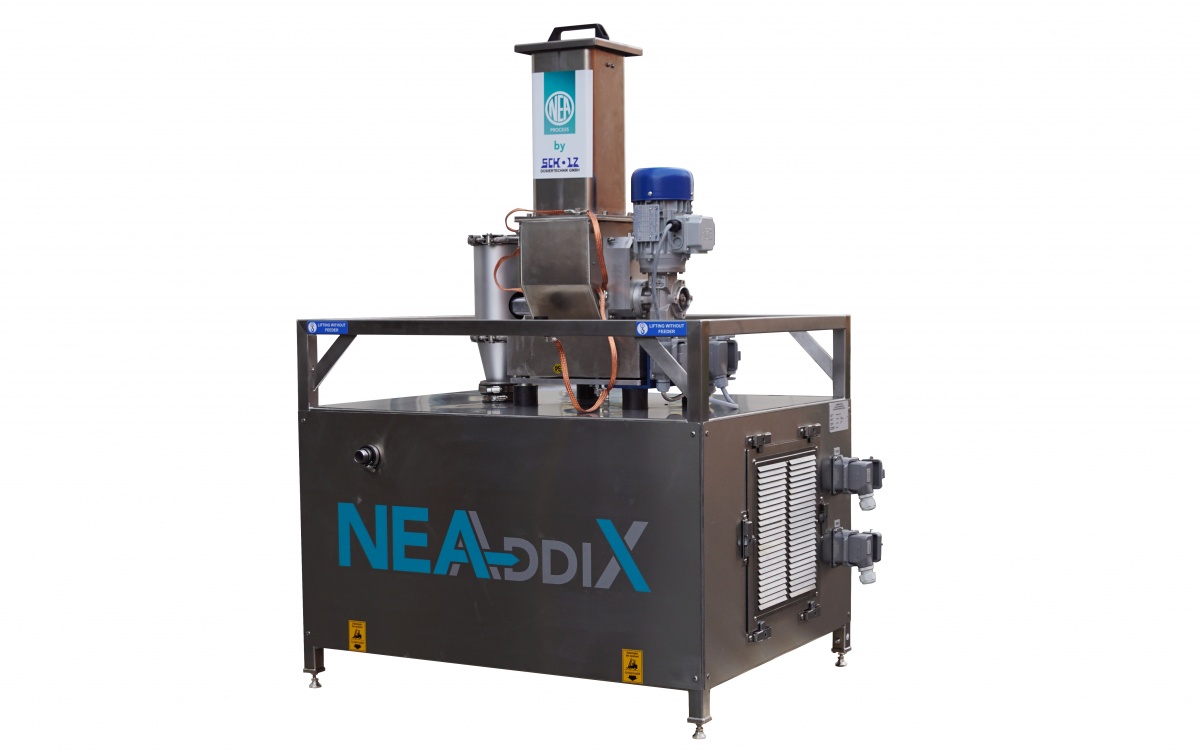
Additives such as aluminum oxide (AL₂O₃) or silicon dioxide (SiO₂, silica) are used in powder coating processing for better flowability of the solid particles and thus to avoid spitting during application. Costs of the additives are a major factor in powder coating production. These costs can be decreased by enhancing the additive dispersion in the powder and thus reducing the required amount of additives while maintaining the desired flowability.
There are a number of additives used in powder coating, such as levelling agents, structural additives, matting agents, flow agents and waxes to influence the surface. Most additives are appended to the premix and intermixed into the formulation during extrusion. Additives that influence the flowability, such as aluminum oxide and silicon dioxide (silica), are mixed with the powder after extrusion. These are known as post-blend additives and are then added either before, after or during grinding. [1]
Primary for the application of powder coating is the flowability. The additives, mainly aluminium oxide and silica, facilitate easy transport, avoids spitting during application, and thereby surface defects. Aluminum oxide also improves storage stability, prevents moisture absorption of powder coatings and improves the edge coating of the substrates. In addition, it increases the electrostatic positive chargeability of tribo powders. [2]
Usually about 20 t – 50 t additives per 10.000 t powder coating are consumed. The target is to reduce the required amount of aluminum oxide or rather of silica during the production. Also the white spots on powder coating surfaces have to be at least significantly reduced if not avoided.
Add additives
In the past, it was common practice to feed the additives manually in powder coating boxes. Later on, powder coating producers added additives at chips container. Finally the additive was fed by rotary airlocks upstream the mill, or by feeding the additives at the sieve after cyclone discharge.
The additive suction inlet allows the additive to be added in front of the mill (Fig. 1), the additive Injector adding agent between cyclone classifier and sieve (Fig. 2).
With the Suction Inlet, the additive is sucked, due to the negative pressure in the powder coating system, into the feeding pipe. The additive flows with the powder coating chips in the ICM (Impact Classifier Mill). In the mill, the additive is mixed with the powder coating. The disadvantage of this set-up is, that a significant part of the additive is lost at the cyclone collector into the filter. With the Additive Injector, the additive is fed by compressed air through the Injector into the NEA Additive Adapter. In the Adapter, the additive is mixed with the final product. In comparison with the Suction Inlet, the additive consumption with the Injector is lower. However, the additive dispersion is not as efficient.
Now a new system was designed to reduce the amount of additive and at once to improve significantly the dispersion in the final powder coating product.
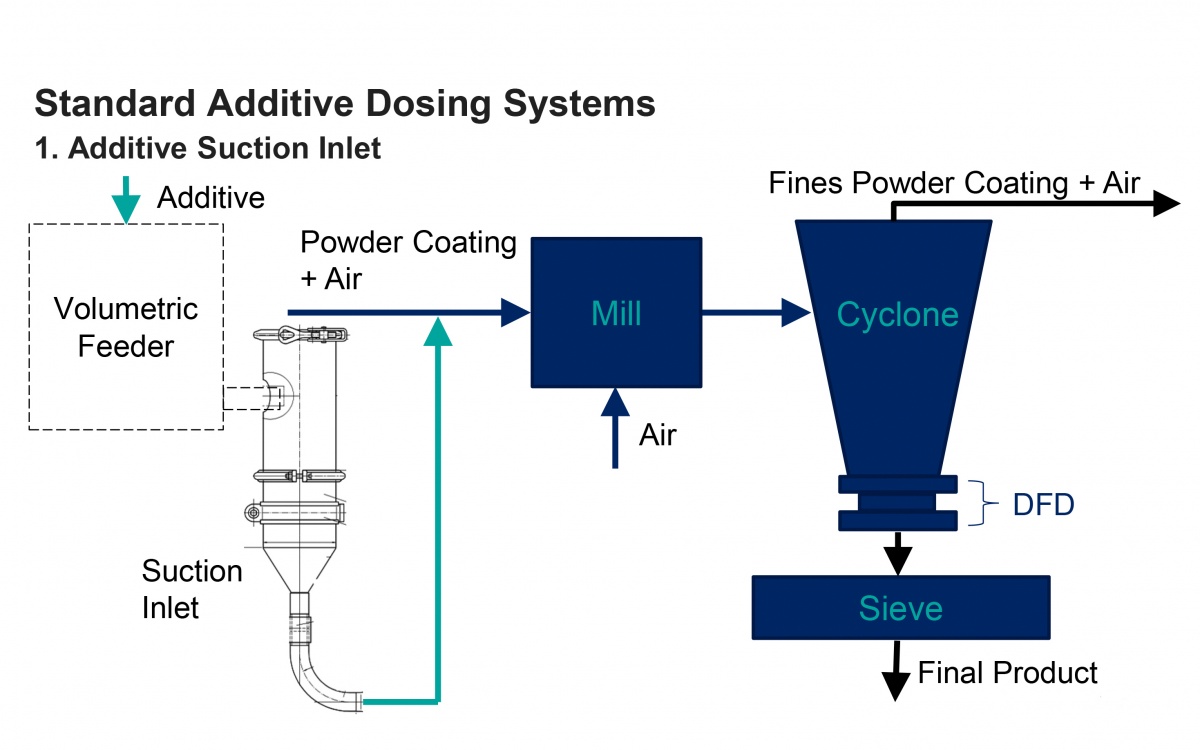
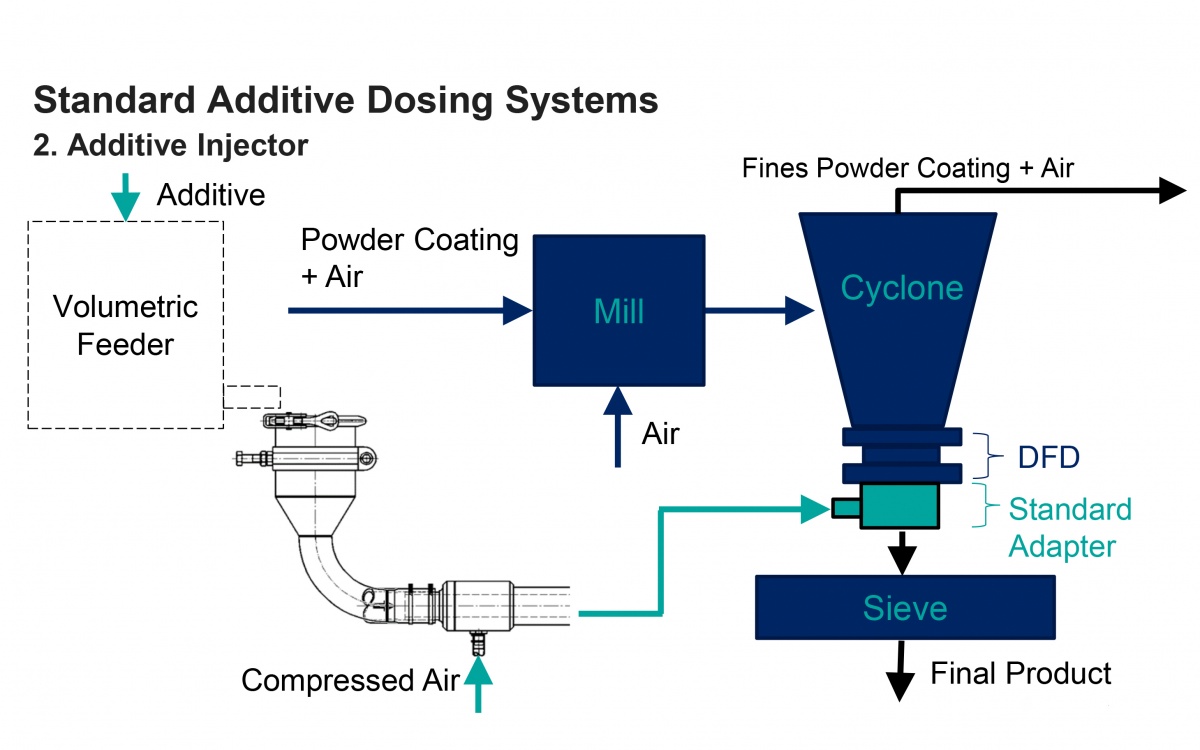
In the grinding system
The new Additive Dosing and Dispersing System consists of an additive dosing and a dispersing unit (Fig. 3). The dosing device consists of a gravimetric dosing and a conveying unit. In contrast to the standard additive systems, the new system feeds the additive gravimetrically. The gravimetric dosing device has a double screw. A blower conveys the additive into the dispersing unit. There the additives are dispersed and mixed with the finished powder coating.
The effects of the new system were compared with both, the Suction inlet and the Additive Injector. For comparison reasons, the additive in the conventional systems was fed with a gravimetric feeder with double screw as well. Tests were conducted under real life conditions at the ICM60 grinding system (Fig. 4) using the same boundary conditions and parameters.
For the tests, the two most common additives were used. Aluminum oxide – Al2O3 – and furthermore silicon dioxide (silica) – SiO2 were fed with the additives systems into the ICM grinding system.
Also the effect of white spots on e.g. black powder-coated surfaces was tested. Therefore black powder coating was ground on the ICM-System with the new additive feeding system. During the trials the additive mass flow was varied in between 0.1% and 0.5% in relation to the powder coating mass flow.
Afterwards the flowability of the final powder coating product was measured with an Anton-Paar Powder Rheometer. The Rheometer measures the shear stress, which correlates with the flowability. The lower the measuring value is, the better the flowability.
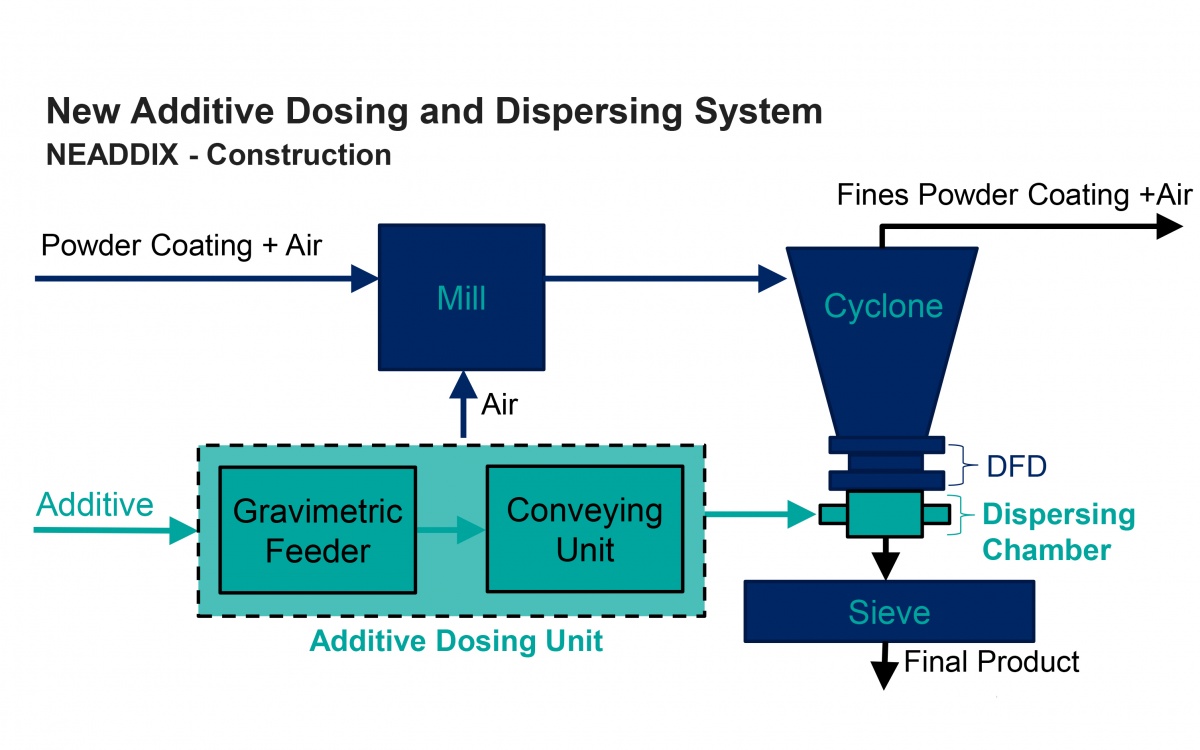
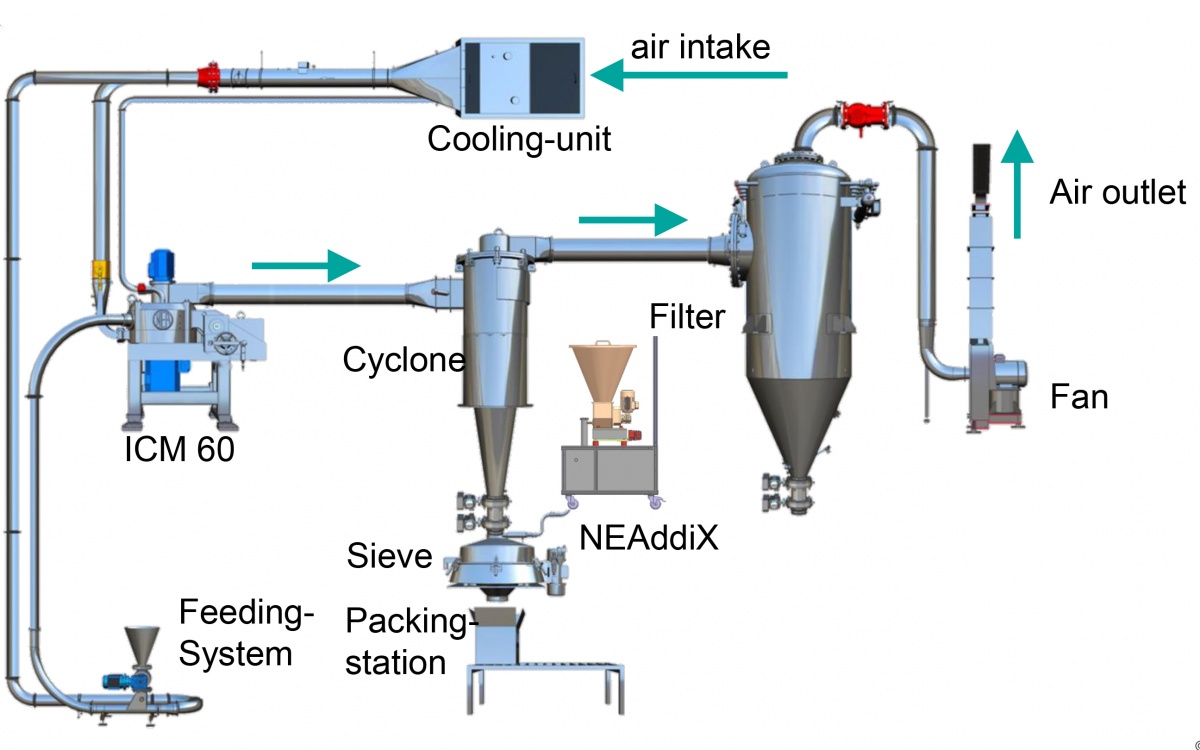
In the rotary rheometer
In order to ensure that the results for the new additive dosage and dispersing system can be checked adequately, a rotary rheometer was used to measure the finished powder coating’s rheological properties (Fig. 5). Primarily, the flow behavior or flowability was examined.
Ground powder coating is placed between a stationary and an oscillating plate. The rotation of the oscillating plate burdens the sample for pure shear, generating transverse stress. Here, the sample is burdened sinusoidally. We distinguish between two different modes: voltage-regulated mode and deformation-controlled mode. In voltage-regulated mode, a defined torque is transferred to the oscillating plate and the transverse stress derived from it. The deformation resulting from the transverse stress is recorded manually. A torsion angle is specified in deformation-controlled mode. The torque required for the deformation is measured and is proportional to the fluid viscosity [3]
Several geometries can be used for the oscillating plate and agitator geometries after calibration, provided that torque and rotary speed can be measured. Often, disk agitators are used such as the Brookfield viscometer and Mooney shearing disk viscometer or blade agitators like the rotating vane. The advantages of this method are good homogeneity of the sample due to the mixing effect and uncomplicated structure, operation, measurement and cleaning [4–6].
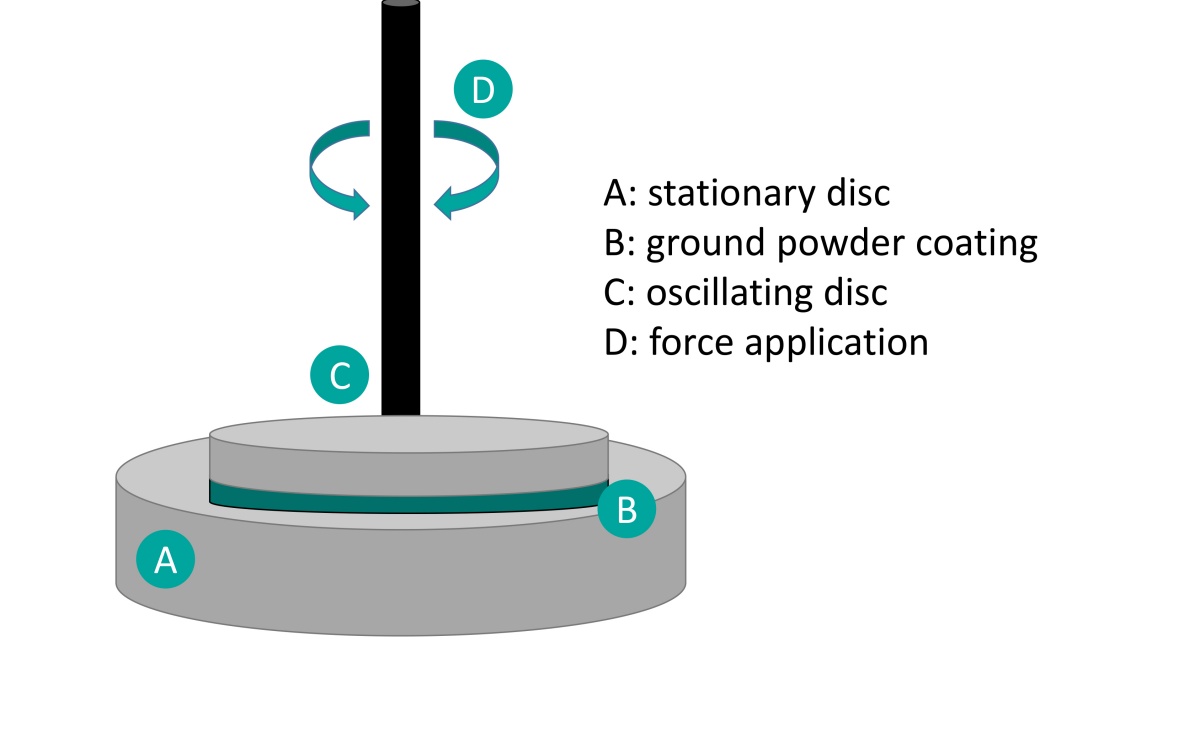
Less is more
Fig. 6 and 7 show the flowability results for the different additive systems depending on the additive mass flow, which is based on the finished powder coating product.
The additive mass flow is set to 0.015 % up to 0.3 % for aluminum oxide and 0.04 % to 0.5 % for silica. The differences between aluminum oxide and silica are the bulk density and the electrostatic charge of the powder. Alumina has a bulk density of approx. 50 g / dm³ and silica one of 150 g / dm³. The electrostatic charge of the silica is higher than that of the aluminum oxide. Because of this, silica contains more agglomerates. According to Fig. 6, the new system achieves a similar flow with 44 % less aluminum oxide than with the additive injector.
In Figure 7 with silicon dioxide the trend is similar than in Figure 6 with aluminum oxide. However, with the new system a similar flowability is achieved with 26 % less silicon dioxide than with the Additive Suction Inlet. Comparative with Additive Injector, with the new system about 63 % silicon dioxide at the same flowability is saved.
Grinding tests with black powder coating and different additive rates in connection with the new system show, that the powder-coated surface do not show white spots.
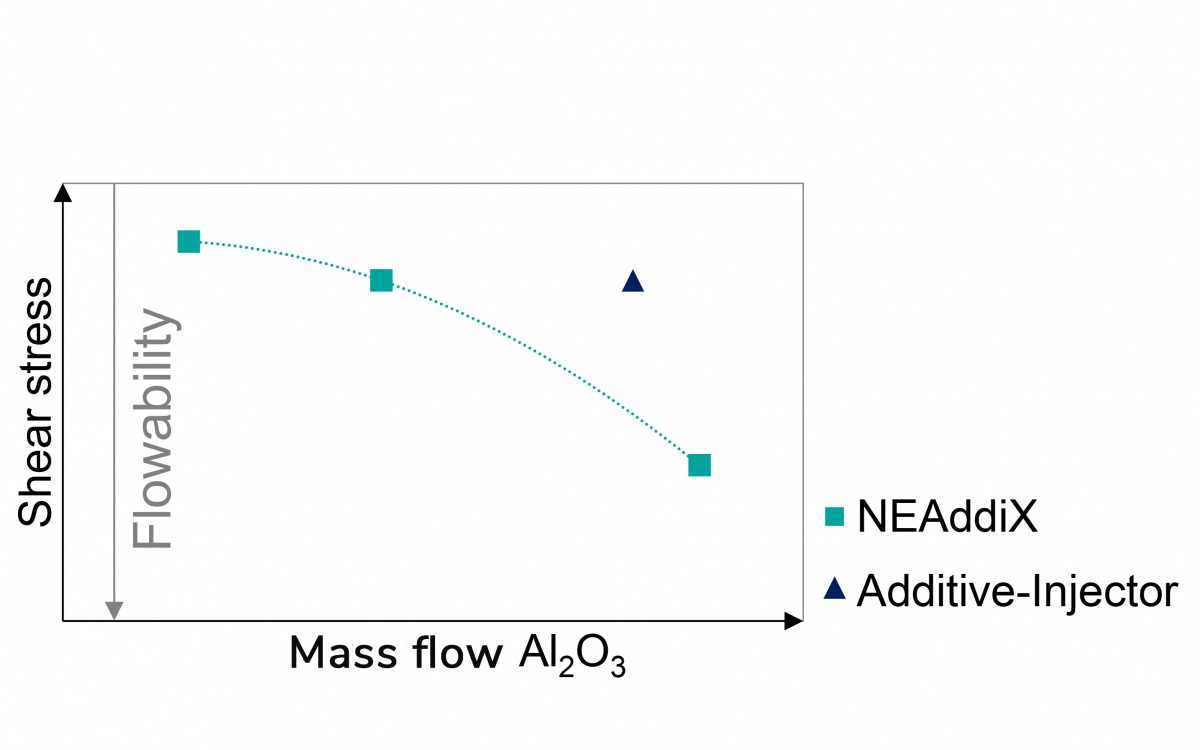
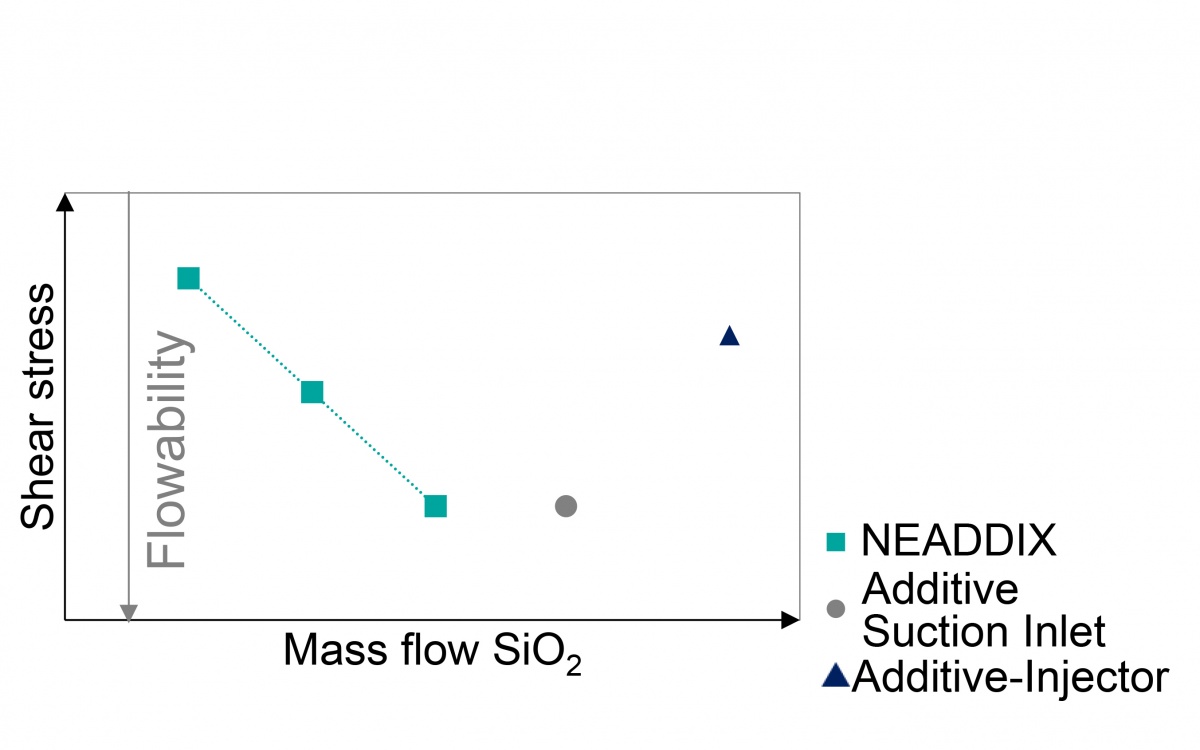
Better dispersed
The new Additive Dosing and Dispersing system combines the advantages of the standard Additive Suction Inlet and the Additive Injector.
Due to two main reasons the additive consumption is reduced with the new system. Firstly the new Additive Dosing Unit achieves in connection with the gravimetric feeder and the Conveying Unit a constant additive mass flow. The gravimetric feeder doses precisely providing a deviation of about 5 % only. The dosing precision of the volumetric feeder depends on the additive bulk density as the volume flow is constant, but mass flow is fluctuating proportional to bulk density variances. In consequence the mass flow deviation can be up to 50°%.
Second reason for the lower additive consumption is the enhanced additive dispersion in the Dispersing Unit. Here the mixing of additive and the final powder coating product is significantly improved.
The new developed Additive Dosing Unit and the better Additive Dispersing Unit reduce the additive consumption by up to 63 % and the powder coating quality is further enhanced.
Outlook
All NEA ICM Systems, whether new or already in operation can be equipped with the new device. For more efficiency, the system can communicate with the NEA by Niverplast Powder Filler retrieving the current mass flow output signal. Using this live information, the additive mass flow is set exactly as needed.
To analyse the effect of other additives on the new system performance, further tests will be carried out. Furthermore, the effect of potential white spots on black and other coloured powder-coated surfaces will be analysed.
Sources
[1] The Role of Additives in Powder Coatings; Paint & Coatings Industry; Fall 1999 Vol. 1; No. 1. [2] AEROSIL und AEROXIDE, Pyrogene Metalloxide für Pulverlacke, Technische Information 1340, EVONIK INDUSTRIES
[3] Schramm G.: Einführung in Rheologie und Rheometrie, Karlsruhe, 1995.
[4] Kulicke W.-M.: Fließverhalten von Stoffen und Stoffgemischen, Hüthig & Wepf, Heidelberg, 1986.
[5] Macosco, C.W.: Rheology - Principles, Measurements and Applications, VCH Verlagsgesellschaft, Weinheim, 1994.
[6] Gehm, L., Teubner, B.G.: Rheologie: Praxisorientiere Grundlagen und Glossar, Stuttgart, 1981.
[7] Chemie, Rheologie und Grenzflächenphänomene in hochviskosen Medien; Institut für Polymerforschung Dresden e.V.; Dresden; 1996.
Interview with Marc Giersemehl
Born in 1970, he studied Process Technology at the university Hochschule Niederrhein in Krefeld. He wrote his diploma thesis about the Cyclone Classifier CSF at NEUMAN & ESSER in 1995 and has worked there continuously since then. Today, as the Technical Managing Director, he is responsible for the technical area including research & development.

Can the resulting advantages for powder coating manufacturing also be transferred to other coating systems?
Is it already possible to say whether reduction of additive consumption also plays such a significant role for other additive types?
How work-intense is the integration of the new system in existing production processes?
The transfer to further coating systems is conceivable – however we have not realized this yet. We know a lot about mechanical processing of powder coatings and have used this opportunity to work out the solution for a permanent subject of debate.
Amazingly little work – our engineers install the unit within two to three hours and then commission it directly. The rheological examinations in the laboratory often take longer than the installation itself. The dosing and dispersion system is set up in such a manner, that it can both be integrated in our existing systems and other manufacturers’ systems.
As most post-blend additives for increasing flowability demonstrate a similar chemical structure to the structure examined in the technical report, we assume that the results can be transferred very well. Moreover, long-term measurements have shown that our system leads to even lower additive consumption than determined by initial examinations at the production process.


CHRISTIAN BEGASS
Born in 1982, he took his Master’s Degree in Development Management at the FH Aachen. He wrote his Bachelor’s thesis at NEUMAN & ESSER in 2010. He then wrote his Master’s thesis at FEV Europe in 2012. Since 2013, he has been the ICM powder coating Product Manager at NEUMAN & ESSER Process Technology.
FABIAN MERTENS
Born in 1991, he took his Master’s Degree in Process Technology at the RWTH Aachen. He wrote his Bachelor’s and Master’s theses at NEUMAN & ESSER in 2014 and 2016. He has worked there in the Research & Development Department since 2014. Prior to this, he completed an integrated degree program in connection with industrial training as an Industrial Mechanic at NEUMAN & ESSER Compressors.

Christian Begass
Product Specialist Powder Coating
+49-2451-481-203
christian.begass_at_neuman-esser.de
NEUMAN & ESSER Process Technology
Werkstr. o. Nr., 52531 Übach-Palenberg
